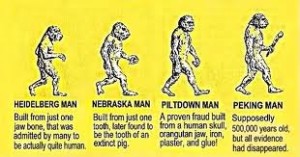Science – Science before fifty thousand years ago
It is remarkable and significant fact that the most primitive examples of early man should be derived from localities so widely apart as the Far East and Western Europe. If the numbers were not so small, such a distribution in itself would suggest dispersal from a common centre such as mid Asia. The occurrence of an early specimen of man in East Africa, not with standing the difference in type, might also favor an Asiatic origin, as being within striking distance of a line of migration from Asia followed by other races in later times. The three primitive types of early man Pithecanthropus, Peking man and Piltodwn man show a striking agreement in certain general characteristics. All of them exhibit features in which they show marked resemblances to the apes, but in others both Peking man and Piltdown man approximate to or foreshadow characters in modern man. These latter characters are not entirely identical in the two types and the differences are perhaps even more instructive than the identities. The results of a detailed comparison of these specimens of early man is , in fact, such as would appear had nature been experimenting along now one, now another, line of advance towards modern man. All the skulls are heavy and massive the bone being extremely thick, although in Pithecanthropus and in Peking man the skulls are small, especially the Peking man skull first discovered at Chouskoutien. Measured in terms of cubic capacity, the skull of Pithecanthropus, so far as can be gauged from the skull cap, had a capacity of nine hundred cubic centimeters only, while the skull known as Peking man is about one thousand cubic centimeters. One of the three Peking skulls recently discovered reaches as high as one thousand two hundred cubic centimeters, but this in probably exceptional. These measurements must be compared with the modern Australian aboriginal at one thousand two hundred and ninety cubic centimeters, though even that is low for a modern type. The modern European averages one thousand four hundred and fifty cubic centimeters. Piltdown probably stands at something over one thousand three hundred cubic centimeters. A comparison of plaster casts of the interior of the skulls which show the form and character of the brain indicates that while the brain of Peking man was one of the most primitive human brains known, that of Piltdown man shows a decided advance towards the modern type. A regards the general appearance of the skulls all agree in being low and having a low receding forehead, like that of the apes, but the most striking feature is the thick heavy ridge or torus of bone which runs across the forehead over the eyes, a mark of primitive man which reappears, as will be seen, in latter types and gives a fierce and repellent cast of countenance, such as is evident though in a less marked degree, in the Australian aborigines. It is a distinctly simian character. After many studies and research about the man’s evolution it is noted that numerous aspects which put forward to the modern science of the world.

